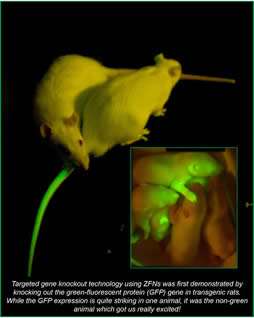
Aron Geurts, PhD
John E. and Genevieve M. Butenhoff Cardiovascular Research Professorship
Locations
- Physiology
Contact Information
Honors and Awards
Research Experience
- Animals, Genetically Modified
- Blood Pressure
- Disease Models, Animal
- Genetic Engineering
- Genetic Research
- Genomics
- Hypertension
- Kidney
- Organisms, Genetically Modified
- Phenotype
- Rats
- Rats, Inbred Dahl
Methodologies and Techniques
- Animals, Genetically Modified
- Cloning, Molecular
- CRISPR-Cas Systems
- Gene Editing
- Gene Expression Profiling
- Gene Knockout Techniques
- Genetic Techniques
- Genetic Vectors
- Genomics
- Models, Genetic
- Mutation
- Organisms, Genetically Modified
MCW Program / Core Facilities
- Rodent Model Resource Center (Director)
Research Interests
Continuing research efforts in the Geurts lab are being driven by our interests in developing genetic approaches toward understanding human health and disease. For the past 12 years, we have been developing tools for genetic manipulation in a variety of cell and animal systems including stem cells, zebrafish, mice and laboratory rats. These systems are among the most widely preferred models for genetic and physiological investigation into human disease, however, genetic approaches, especially in non-mouse systems, have traditionally been limited by a lack of technologies.
After joining the Medical College in 2006, we implemented new approaches to accelerate transgenic and gene knockout studies for the PhysGen Program for Genomic Applications by adapting the Sleeping Beauty transposable element system for use in rats. Transposons are currently the most reproducible and efficient tool available for adding new genes to the rat genome and since then, we have worked with several other local investigators to create new transgenic rat models.

More recently, the Geurts lab has been developing TAL Effector Nuclease (TALEN) technology for targeted genome engineering. TALENs are a relatively new technology which are analogous to ZFNs, but have some attractive attributes including reduced cost and design flexibility which will facilitate their use in the field. This new technique is complemented by our recent development of the first rat embryonic stem cells from a hypertensive rat model in collaboration with the laboratory of Dr. Howard Jacob. The availability of stem cells from this disease model rat now provides unique possibilities for creating more complicated genetic models. We are currently establishing whether these cells are capable of supporting our engineering approaches for producing genetically modified rats.
Recently, Dr. Geurts' creative and innovative contributions to the field of genetics and technology were recognized by the granting of a New Innovator Award from the Office of the Director of the National Institutes of Health. This prominent award will propel efforts in the Geurts lab toward pushing the limits of these technologies to create better models of human disease. These techniques, animal models, and resources broadly benefit the local and broader research communities and advance our collective understanding of complex human genetic diseases.
Publications
-
The role of carnitine palmitoyl transferase 2 in the progression of salt-sensitive hypertension.
(Dissanayake LV, Smith BA, Zietara A, Levchenko V, Lowe M, Kravtsova O, Shapiro A, Upadhyay G, Halade GV, Geurts AM, Palygin O, Staruschenko A.) Am J Physiol Cell Physiol. 2025 Oct 01;329(4):C1188-C1202 PMID: 40897451 PMCID: PMC12462776 SCOPUS ID: 2-s2.0-105017327500 09/03/2025
-
(Takizawa A, Foeckler J, Knapp E, Grzybowski M, Geurts AM, Carroll J, Merriman DK.) Mol Reprod Dev. 2025 Sep;92(9):e70055 PMID: 40891659 SCOPUS ID: 2-s2.0-105014800254 09/02/2025
-
(Liu Y, Pandey R, Qiu Q, Liu P, Xue H, Wang J, Therani B, Ying R, Usa K, Grzybowski M, Yang C, Mishra MK, Greene AS, Cowley AW Jr, Rao S, Geurts AM, Widlansky ME, Liang M.) Nat Commun. 2025 Jul 17;16(1):6577 PMID: 40675959 PMCID: PMC12271514 SCOPUS ID: 2-s2.0-105011067559 07/18/2025
-
Physiological role and mechanisms of action for a long noncoding haplotype region.
(Xue H, Mishra MK, Liu Y, Liu P, Grzybowski M, Pandey R, Usa K, Vanden Avond MA, Bala N, Alli AA, Cowley AW Jr, Qiu Q, Greene AS, Rao S, O'Meara CC, Geurts AM, Liang M.) Cell Rep. 2025 Jun 24;44(6):115805 PMID: 40493452 PMCID: PMC12263090 SCOPUS ID: 2-s2.0-105007437771 06/10/2025
-
A Novel GH Deficient Rat Model Reveals Cross-Species Insights Into Aging.
(Myint SMMP, Lasher AT, Liu K, Geurts AM, Austad SN, Sun LY.) Aging Cell. 2025 Jun 05;24(8):e70126 PMID: 40474491 PMCID: PMC12341780 SCOPUS ID: 2-s2.0-105007351623 06/06/2025
-
(Fitzpatrick MK, Dyson C, Beeson A, Adrian L, Marrs G, Grzybowski M, Klotz J, Geurts AM, Chen R, Weiner JL, Solberg Woods LC.) Genes Brain Behav. 2025 Jun;24(3):e70028 PMID: 40492272 PMCID: PMC12149762 SCOPUS ID: 2-s2.0-105007863205 06/10/2025
-
(Fitzpatrick MK, Dyson C, Beeson A, Adrian L, Marrs G, Grzybowski M, Klotz J, Geurts AM, Chen R, Weiner JL, Solberg Woods LC.) bioRxiv. 2025 Apr 02 PMID: 40236087 PMCID: PMC11996401 04/16/2025
-
Establishing the hybrid rat diversity program: a resource for dissecting complex traits.
(Dwinell MR, Takizawa A, Tutaj M, Malloy L, Schilling R, Endsley A, Demos WM, Smith JR, Wang SJ, De Pons J, Kundurthi A, Geurts AM, Kwitek AE.) Mamm Genome. 2025 Mar;36(1):25-37 PMID: 39907792 PMCID: PMC11880076 SCOPUS ID: 2-s2.0-85217741215 02/05/2025
-
(Ray A, Yang C, Stelloh C, Tutaj M, Liu P, Liu Y, Qiu Q, Auer PL, Lin CW, Widlansky ME, Geurts AM, Cowley AW Jr, Liang M, Kwitek AE, Greene AS, Rao S.) Hypertension. 2025 Mar;82(3):476-488 PMID: 39723540 PMCID: PMC12236357 SCOPUS ID: 2-s2.0-85213707759 12/26/2024
-
(Fitzpatrick MK, Dyson C, Beeson A, Adrian L, Marrs G, Grzybowski M, Klotz J, Geurts AM, Chen R, Weiner JL, Solberg Woods LC.) Genes Brain and Behavior. June 2025;24(3) SCOPUS ID: 2-s2.0-105007863205 06/01/2025
-
(Fitzpatrick MK, Szalanczy A, Beeson A, Vora A, Scott C, Grzybowski M, Klotz J, Der N, Chen R, Geurts AM, Solberg Woods LC.) Obesity (Silver Spring). 2025 Jan;33(1):91-103 PMID: 39632398 PMCID: PMC12247540 SCOPUS ID: 2-s2.0-85211109928 12/05/2024
-
(Liu Y, Pandey R, Qiu Q, Liu P, Xue H, Wang J, Therani B, Ying R, Usa K, Grzybowski M, Yang C, Mishra MK, Greene AS, Cowley AW Jr, Rao S, Geurts AM, Widlansky ME, Liang M.) bioRxiv. 2024 Oct 14 PMID: 39463975 PMCID: PMC11507733 10/28/2024


